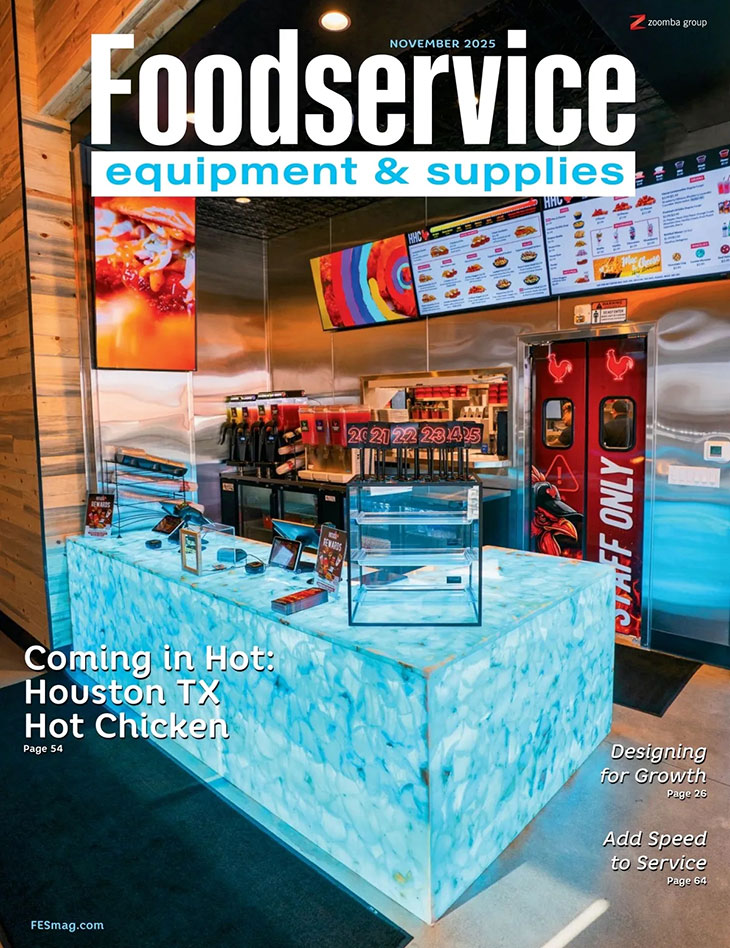It’s now or never. I strongly believe that 2019 is going to be the year when restaurants will really need to pick up their speed and think toward the future — or risk getting left in the dust.
 Chris Tripoli, FCSI, Founder, A La Carte Consulting Group, HoustonDuring a lunch meeting with the chief executive officer of a fast-growing salad concept, even he agreed on the importance of being a step ahead. He shared that the chain’s management had named achieving more relevance in the marketplace as its biggest goal this year. The chain is well established and has a pretty aggressive expansion plan, with about 75 stores in existence and 50 more on the way, but that’s not good enough.
Chris Tripoli, FCSI, Founder, A La Carte Consulting Group, HoustonDuring a lunch meeting with the chief executive officer of a fast-growing salad concept, even he agreed on the importance of being a step ahead. He shared that the chain’s management had named achieving more relevance in the marketplace as its biggest goal this year. The chain is well established and has a pretty aggressive expansion plan, with about 75 stores in existence and 50 more on the way, but that’s not good enough.
These days consumers have so many more choices in terms of where to eat and when, and they expect immediate satisfaction and near-perfect experiences. Lots of restaurant executives feel this pressure and will tell me, “If we don’t figure out what’s next and we allow ourselves to think that being good is good enough, we are going to lose.”
So, where does that leave us as an industry and end-user support players? Restaurant owners and operators need to open their minds to greater possibilities and goals and then put plans in place to execute. I call this “continued improvement.” How do we demonstrate that we are not going to be satisfied with the status quo, even if we’re currently doing well? How do we embrace change and strive every day to be better than the day before?
There are a few key steps to take when striving for continued improvement. I call them “the Triple E’s”: embrace, engage and empower.
Step 1: Embrace Change
Embracing change means demonstrating the willingness to improve and modify even those aspects of an operation that work well. For example, a small restaurant operator might look to improve systems and make decisions faster. With so many new technologies on the market, now operators that still communicate with their staff via bulletin boards just because it’s worked for years are essentially telling their staff the world they live in isn’t that important to business. Operators need to explore and implement cloud-based scheduling and cloud-based communication.
Energy efficiency, sustainability and care for the environment continue to be extremely important to staff and consumers. Operators not embracing some or all of these areas of sustainability in the everyday management of their businesses send a signal that they don’t care what the rest of the world cares about and wants to see. It sounds harsh, but consumers enjoy doing business with people they like.
Sometimes it takes a wake-up call to prevent being stuck in the mud. And this can apply to all types of businesses in our industry.
Step 2: Engaging Others
Engaging others starts with bringing staff together for something other than a routine meeting where a manager barks orders. Instead, try approaching things with a “quality circle.” This is more of an open forum during which all staff members have the opportunity to tell management the things they would like to see improved in order to make their jobs simpler and enhance the guest experience. Maybe there’s a better way to work behind the bar, maybe there’s a better glass to use, better equipment to purchase or a better schedule for side work. Engaging others also means engaging customers and getting regular feedback. One way to achieve this is through focus groups and digital technology like emails, e-newsletters and online surveys. If we’re not engaging the customer to rate us, provide comments and tell us how to improve, then they’re going to spend time eating somewhere that will — it’s that simple.
Pal’s Sudden Service, a quick-serve restaurant out of Tennessee, serves as a great example of a regional chain that does an amazing job with elevating the guest experience and engaging with customers — both in stores and online. The chain also has a very positive work environment and offers regular seminars and continued education opportunities for staff.
Spirits Food and Friends, a single-unit, husband-and-wife-owned, full-service casual restaurant in Alexander, La., also does an amazing job with staff engagement. In this market, where chains mostly dominate, the restaurant manages to stay full every day and night. What started with an occasional manager meeting has led to a well-developed annual plan, monthly objectives and quarterly quality circles during which the whole team works on making improvements. Building on its success, the restaurant now schedules customer focus groups, coupled with regular outreach, to make sure management listens to what the diners want.
Step 3: Empowering Management and Staff
After making the switch from boring, wasteful meetings where only one person talks and gives orders, to gatherings in which everyone participates equally, it’s easier to achieve buy-in and expect improved consistency within the operation. It’s important that everyone becomes knowledgeable about their role and what the goals are for the day, week, month, quarter and year.
I also encourage restaurant operators to avoid just making goals around revenue and foot traffic. Sure, every business wants to be busier, but the discussion needs to focus on how the operation can be better. Specifically, how can the restaurant empower staff to improve service, sell more and keep the facility cleaner? How can the foodservice operation empower the kitchen team to prepare better food and faster? How can the business leaders empower managers to meet monthly objectives and conduct some type of training each day? Finally, how will the team empower the restaurant owner to direct, support and evaluate everyone else? How will the operation define its standards for service, cleanliness, brand recognition and more, and how will everyone get there as a team?
The bottom line is that, when it comes to continued improvement, too often I see and hear people bring up the same ideas. Everyone wants to talk about the competitive nature of the market, but we don’t have to fear competition; we can learn from our competitors and make improvements based on them. We don’t have to fear increasing costs; those are things we can plan for and make a budget. We don’t have to fear a tight labor market, especially if we research new technologies to improve efficiencies and engage and empower our staff to enjoy their work and stay longer with the company.
There’s only one thing I tell my clients — and myself, for that matter — to fear, and that’s mediocrity. Making a commitment to continued improvement is how we as companies, individuals and as an industry, will keep getting better than good — day in and day out.



